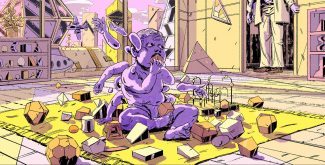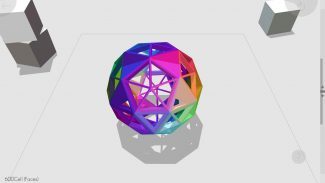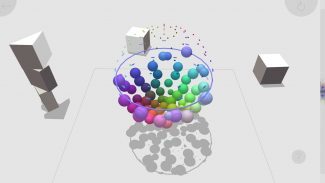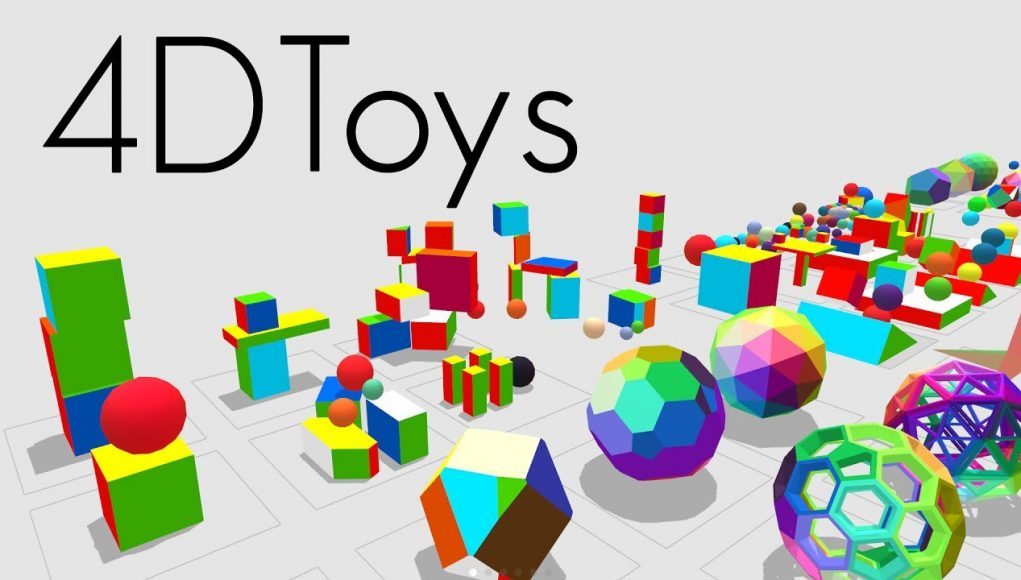Marc ten Bosch’s side project 4D Toys is a unique physics-based toy box using the game engine he created for Miegakure, a groundbreaking 4D puzzle-platformer. Launched on June 2nd for SteamVR and iOS, the app simulates an environment with a fourth spatial dimension, where players can freely manipulate four-dimensional objects with dynamic physics.

Starting the app for the first time, you’re greeted by a set of artworks that form a short, suitably abstract comic strip offering a loose explanation for why a mind-bending toy box like this might exist, and then you’re thrown right in. Most of the objects are immediately accessible, laid out in a grid, allowing the user to choose a particular shape or set of shapes to play with. Ten Bosch recommends that VR users sit on the floor (and ensure that the virtual floor aligns with your own) to give the best feeling of engagement. His intention is to offer an undirected experience, giving any player a childlike sense of wonderment as they discover these ‘impossible’ toys.
While messing around in any physics-based environment can be entertaining, it’s important to have a basic understanding of what’s going on here. At first glance, to our three-dimensional visual perception, it looks like spheres enlarge and shrink at random, cubes get sliced at odd angles and objects ‘clip’ through invisible planes. But these are hyperspheres and hypercubes, and this apparent shape-shifting is a genuine mathematical representation of four-dimensional objects moving within four spatial dimensions, appearing and disappearing from our view – a mere ‘3D slice’ of a 4D scene. Frankly, the creator does a much better job of explaining the system than I ever could, so I’d strongly recommend watching the video below:
The ‘flatland’ used to demonstrate how 3D objects would appear to a 2D character is available in the app, along with an interactive, written explanation of the full 4D system. Over 100 ‘scenes’ have been prepared, which include a large number of increasingly complex 4D objects, from your common or garden tesseract to the delightfully exotic omnitruncated variant… it’s heavy stuff. Many scenes combine multiple objects that bounce off each other in interesting ways. The physics implementation results in some unusual effects – you can throw a 4D object between your hands as if it’s 3D, because you are operating in 3D too, but as soon as you bounce it off a wall or another object, it’ll change appearance or even disappear, becoming more unpredictable as it tumbles along the fourth dimension.
One peculiar scene contains two interlocked 4D rings, which can only be separated by engaging with the fourth dimension. Unlike other scenes where objects easily change their appearance from impacts, the rings remain locked as you throw them around, and only change with many hard impacts or by manually adjusting the fourth dimension slider. I asked Marc if this was an ‘artificial lock’ on the physics for this particular scene, and he explained that it’s actually a detail of his physics implementation – “the rings (and the spheres) can start perfectly mathematically balanced, which can’t happen in real life and makes them very stable until you offset them or they collide a bunch”.

4D Toys was initially created for iOS – “VR wasn’t even a thing when I started it!” says Marc – but it was developed on PC simultaneously thanks to its cross platform engine, and the transition to VR “didn’t take very long and was well worth it”. The app has some advantages on iOS, as those with dexterous fingers could manipulate more than two objects at once using multi-touch, and it’s possible to tilt the entire world with the accelerometer. The non-VR versions (the SteamVR version can be played on a standard display with a mouse and keyboard) also allow you spin objects quickly to make 4D spinning tops, and you can see the 2D and 3D viewpoints in split screen for the ‘flatland’ levels. However, the VR experience is probably the most compelling, thanks to the depth sensation, more intuitive controls, and the ability to easily manipulate objects and even juggle two objects at once with motion controllers.
Is it a great VR showcase? For those of a certain mindset, it’ll push the right buttons. While it’s a very literal demonstration of using VR to perform physically impossible feats, it’s probably not for everyone. Some may see it simply as a physics-based toy box with objects that exhibit bizarre behaviour, and not really appreciate its creative and technical achievements. Others will find pure joy in tossing a hecatonicosachoron between their hands. Visualising a fourth spatial dimension is inherently an abstract concept, but 4D Toys somehow manages to give the player a ‘feel’ for it.
This undirected play is a contrast to Miegakure, which will carefully lead the player through finely-tuned levels of increasing complexity. Their 4D implementations are different too – in 4D Toys, you use your thumbs to scroll, translating your ‘slice’ along the fourth dimension, marked by a vertical slider, with a granular control over the offset. In Miegakure, you press a button and your ‘slice’ automatically rotates through 90 degrees rather than translating, press the button again to rotate back to the initial orientation, and you can’t move your character until it is done rotating. In other words, 4D Toys is considerably more ‘freeform’ by design, showcasing the remarkable 4D engine that powers Miegakure in a meaningful way.

As explained on ten Bosch’s official blog, the project is the result of creating 4D physics for Miegakure, a game he has been working on since 2009. The physics system was intended ‘as a purely aesthetic component’, but 4D Toys has benefitted Miegakure significantly, inspiring many ideas for levels and scenes.
The success of 4D Toys also means that VR support for Miegakure is likely. Colin Northway of Fantastic Contraption fame can be seen trying the first prototype in a tweet from October last year. “The game takes place on a small island in the middle of the VR area and you still hold a regular controller to move your character”, says ten Bosch. “It’s pretty cool, you can make the island larger and feel what it’s like from an almost first-person perspective, then make it smaller and keep playing from a vantage point where you can see everything”.
The VR version of 4D Toys is available on Steam.







